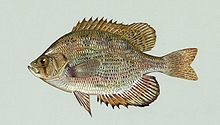Centrarchid
| Sunfishes Temporal range: Late Eocene to Recent |
|
|---|---|
 |
|
| Flier (Centrarchus macropterus) | |
| Scientific classification | |
| Kingdom: | Animalia |
| Phylum: | Chordata |
| Class: | Actinopterygii |
| Order: | Perciformes |
| Superfamily: | Percoidea |
| Family: |
Centrarchidae Bleeker, 1859 |
| Genera | |
|
See text |
|
 |
|
| Sunfish range | |
See text
The sunfish are a family (Centrarchidae) of freshwater ray-finned fish belonging to the order Perciformes. The type genus is Centrarchus (consisting solely of the flier, C. macropterus). The family's 37 species include many fish familiar to North Americans, including the rock bass, largemouth bass, bluegill, pumpkinseed, and crappies. All are native only to North America.
Family members are distinguished by having at least three anal spines. The dorsal spines are five to 13 in number, but most species have 10–12. The pseudobranch is small and concealed. Sizes of most are in the 20 to 30 cm (7.9 to 11.8 in) range. However, some are much smaller, with the black-banded sunfish at just 8 cm (3.1 in) in length, while the largemouth bass is reported to reach almost 1 m (3.3 ft) in extreme cases.
The male of most species builds a nest by hollowing out a depression using his tail, then guards the eggs.
Most sunfish are valued for sports fishing, and have been introduced in many areas outside their original ranges, sometimes becoming invasive species. While edible, they are not commercially marketed as a food fish.
The earliest fossils of Centrarchidae are from latest Eocene to early Oligocene deposits from Montana and South Dakota, belonging to several as yet undescribed species and the two extinct genera †Plioplarchus and †Boreocentrarchus. Both Plioplarchus and Boreocentrarchus are classified in the subfamily Centrarchinae, because these species possess more than three anal fin spines.
...
Wikipedia
